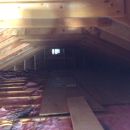
In the Heat and Cold, Your Attic Can Have Mold – Part I
The attic: a space in your home that houses Christmas decorations, bins of seasonal clothes and the occasional tarantula-sized spider that makes you cringe at the thought of venturing up to this dark and desolate space. However, while you may be like me and only make your way up to your home’s attic when you absolutely need to, what many New Hampshire (NH) homeowners do not realize is that this dark, moist area may also be home to mold growth. Since the attic is not as frequented as other locations in the home, mold can form and grow quickly and discretely, and may only become noticed when other issues arise from the growth.
What Causes Attic Mold?
Mold is one of those nuisances that many homeowners never want to see in their home, especially in the attic. So, what exactly is mold and how does it get in a vacant space such as the attic? Mold is a type of multi-cellular fungi that is made up of microorganisms, which are mostly composed of dead organic matter such as leaves and plants. Mold can come in a variety of sizes, shapes and colors, ranging from white to black, and can affect any area in your home, including the attic. The most common causes of attic mold are:
- A leak in your home’s roof: A leaky roof may cause water to leak onto the attic walls and floor, resulting in the perfect combination of moisture and a dark location for mold to grow.
- Insulation not installed properly: Since heat and moisture rises in a home, the water vapors can get trapped in the insulation, causing mold to form and grow.
- Limited or no ventilation: Ventilation is key to helping prevent mold growth, especially in the attic. Keeping vents and the underside of your home’s roof free from debris, insulation and seals will help to keep proper air flow.
- Ice dams: A build-up of snow and ice that occurs at the edge of a roof. Ice dams can prevent snow from melting off the roof, resulting in the water backflowing into the home.
- Dryer or bathroom vents flowing into the attic: Vents or outlets from bathroom fans or dyers leading into the attic can cause excessive moisture to build-up, which may result in mold growth.
Do I Have Attic Mold?
Do certain locations in your home have a musty smell? Was there a recent rainstorm that caused flooding and may have damaged your roof? If so, you may want to be on alert for mold, particularly in your attic. If you suspect mold in this space, a few signs to be on the lookout for are:
- A musty odor.
- Visible mold growth (these may appear as small areas of dirt or soot).
- Health symptoms resembling allergies (sneezing, watering eyes, etc.).
- Knowledge of past water damage or excessive condensation in the attic.
- A roof leak.
- Water stains the attic floor or celling.
Soil-Away Is Here for You
Discovering mold at your property is not fun. We understand that no one ever wants to experience this frustrating situation, but know that the experts at Soil-Away are here to make things less stressful. Soil-Away is a family-owned and operated business that is IICRC master-certified and has over 25 years of experience. We work closely with insurance companies during the remediation process to ensure a smooth, less-stressful process, so you can get back to the things that matter most. Contact the mold remediation experts today at 603-641-6555.
Stay tuned for Part II of this two-part series on how to keep mold out of your attic!
Written by: K. Gnatowski

